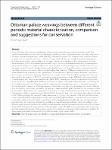Item Infomation
Full metadata record
| DC Field | Value | Language |
|---|---|---|
| dc.contributor.author | Güzel, Emine Torgan | - |
| dc.date.accessioned | 2023-08-28T02:06:18Z | - |
| dc.date.available | 2023-08-28T02:06:18Z | - |
| dc.date.issued | 2023 | - |
| dc.identifier.uri | https://link.springer.com/article/10.1186/s40494-023-01016-0 | - |
| dc.identifier.uri | https://dlib.phenikaa-uni.edu.vn/handle/PNK/8967 | - |
| dc.description | CC-BY | vi |
| dc.description.abstract | Historical textiles, which are an invaluable part of the cultural material heritage, and the materials used in their production bear witness to the social past. Although a textile object was originally produced out of necessity, later it became a symbol of magnificence, power, and might. The most important basic elements that contribute to these properties are the materials used in its production, among which silk fiber, and metallic threads containing gold and silver are the leading ones. In addition to the aging behavior of textile objects due to their organic structure, the deterioration process is accelerated due to various factors such as use, environmental factors, mismanagement, inappropriate storage and display conditions, incorrect restoration-conservation practices, natural disasters, etc. | vi |
| dc.language.iso | en | vi |
| dc.publisher | Springer | vi |
| dc.subject | Ottoman palace | vi |
| dc.subject | material characterization | vi |
| dc.title | Ottoman palace weavings between different periods: material characterization, comparison and suggestions for conservation | vi |
| dc.type | Book | vi |
| Appears in Collections | ||
| OER - Khoa học Vật liệu, Ứng dụng | ||
Files in This Item:

